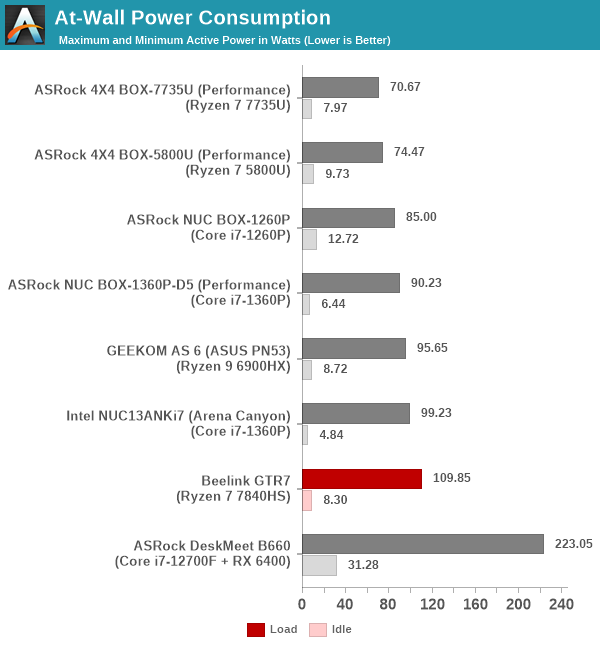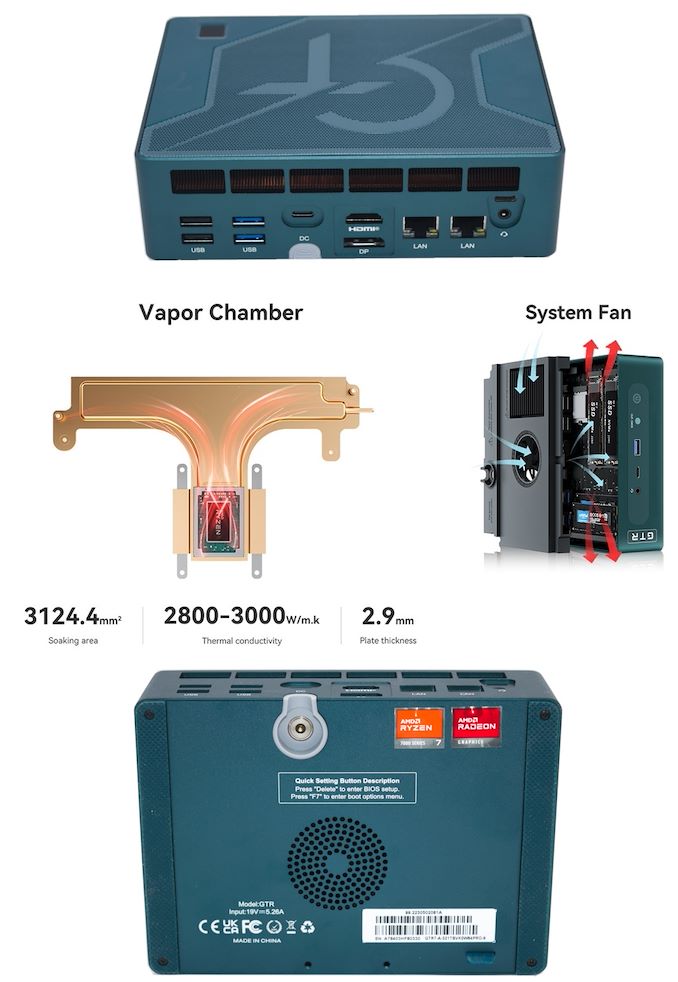Beelink GTR7 mini-PC Review: A Complete AMD Phoenix Package at 65W
by Ganesh T S on August 24, 2023 8:00 AM ESTPower Consumption and Thermal Characteristics
The power consumption at the wall was measured with a 4K display being driven through the HDMI port of the system. In the graph below, we compare the idle and load power of the Beelink GTR7 with other systems evaluated before. For load power consumption, we ran the AIDA64 System Stability Test with various stress components, as well as our custom stress test with Prime95 / Furmark, and noted the peak as well as idling power consumption at the wall.

The numbers are consistent with the TDP and suggested PL1 / PL2 values for the processors in the systems, and do not come as any surprise. Idle power consumption of Intel-based systems is very impressive, with the Arena Canyon NUC able to hit a sub-5W number. The GTR7 idles at 8.3W - while this is better than the GEEKOM AS 6, we blieve Beelink can work further to optimize this number. The 110W load number is consistent with the 65W TDP of the Ryzen 7 7840HS.
Stress Testing
Our thermal stress routine is a combination of Prime95, Furmark, and Finalwire's AIDA64 System Stability Test. The following 9-step sequence is followed, starting with the system at idle:
- Start with the Prime95 stress test configured for maximum power consumption
- After 30 minutes, add Furmark GPU stress workload
- After 30 minutes, terminate the Prime95 workload
- After 30 minutes, terminate the Furmark workload and let the system idle
- After 30 minutes of idling, start the AIDA64 System Stress Test (SST) with CPU, caches, and RAM activated
- After 30 minutes, terminate the previous AIDA64 SST and start a new one with the GPU, CPU, caches, and RAM activated
- After 30 minutes, terminate the previous AIDA64 SST and start a new one with only the GPU activated
- After 30 minutes, terminate the previous AIDA64 SST and start a new one with the CPU, GPU, caches, RAM, and SSD activated
- After 30 minutes, terminate the AIDA64 SST and let the system idle for 30 minutes
Traditionally, this test used to record the clock frequencies - however, with the increasing number of cores in modern processors and fine-grained clock control, frequency information makes the graphs cluttered and doesn't contribute much to understanding the thermal performance of the system. The focus is now on the power consumption and temperature profiles to determine if throttling is in play.
The cTDP of the processor is evident in the reported STAPM power numbers. This 'skin-temperature aware power management' number has a slow rise towards the 65W number even as the package power holds steady at 65W. This behavior is unlike what was observed with the Ryzen 9 6900HX in the GEEKOM AS 6 that had a 65W momentary burst, followed by a 54W mode before finally settling at 35W.
The core temperature is kept well south of 90C and the GPU below 75C throughout the process. Once the STAPM reaches 65W, a little bit of throttling takes effect and the package power drops by a watt or so. However, the vapor chamber cooling solution is good enough to keep the package power stable between 64W and 65W.
Another unique feature of the Beelink GTR7 is the second fan on the underside (Beelink refers to it as the 'system fan'). It creates airflow around the SODIMMs and the upper part of the M.2 2280 SSDs. The lower part closer to the connector is handled by thermal pads that transfer heat to a metal heat sink pictured above. In our stress test, this solution contributes to the DIMM temperatures topping out at 70C (max. 80C) for the upper one, and 85C (max. 96C) for the lower one (as it lies sandwiched between the board and the upper SODIMM). The SSD is also appropriately cooled, with maximum temperatures being 71C and 81C at the two measurement points, though the stable numbers appear to be around 65C and 70C. Form-factor limitations mean that this is probably the best that can be done in terms of cooling for these components at the desired price point. Slight tweaks to the form-factor may allow for vertical SODIMM placement with improved airflow to reduce temperatures even further. However, as it stands, the current solution is a satisfactory one for consumer use-cases. 24x7 stressing for the SSDs or DRAM may be more challenging, but that is a problem for all other UCFF systems in the market too.













56 Comments
View All Comments
lemurbutton - Thursday, August 24, 2023 - link
You can get a M2 Mini for $499 on sale. It's superior to this in just about every way. Even if you upgrade the RAM for $200, it's still better than this. Faster CPU, faster GPU, has AI inference, faster RAM, significantly lower power requirements.meacupla - Thursday, August 24, 2023 - link
Well, yeah, obviously the $499 M2 mini is cheaper.It's a weaker PC than this, in every single metric.
It only has 8GB of RAM, 128GB SSD, both of which cannot be upgraded later on.
It's CPU and GPU are weaker than a 7840HS. To top it off M2 runs less efficiently and hotter.
Which is exactly why no one is buying it, and Apple had to halt M2 production.
ingwe - Thursday, August 24, 2023 - link
The mac mini has a 256GB SSD. Probably doesn't really need the ram upgrade. But...upgrading the SSD to 1 TB is $400. And not sure what you are saying about the M2 running less efficiently. Mac Mini is a fine option imo. But I would much rather have the GTR7 for a lot of reasons. Would be great for a streaming PC and console replacement for older games.PixyMisa - Thursday, August 24, 2023 - link
You can buy two 4TB SSDs for $400.Benjiro29 - Monday, November 6, 2023 - link
Hell, you can buy:* 8TB SSD for 320 Euro now. Or 2 * NVME for 320. Apple asks for 256GB "upgrade": 230 Euro
* 8GB DDR5 5600 Memory costs for 25 Euro. Apple asks for 8GB "upgrade: 230 Euro.
Insane ...that memory that Apple uses is just standard DDR5 memory, nothing special about it beyond being placed in quad channel configuration.
qwertymac93 - Thursday, August 24, 2023 - link
Does it run Windows 11 pro?bji - Thursday, August 24, 2023 - link
Why in the world would anyone *want to* though?TheinsanegamerN - Thursday, August 24, 2023 - link
Point taken, but so long as apple keeps doing its walled garden BS people will continue to rely on other OSes.ActionJ26 - Friday, August 25, 2023 - link
Why would anyone want to use iOS. My last company did and compared to Windows it is trash. Never thought I would say that. Some much of the functionality requires store bought add ones.darkswordsman17 - Friday, August 25, 2023 - link
Er, Mac Mini runs MacOS, not iOS.